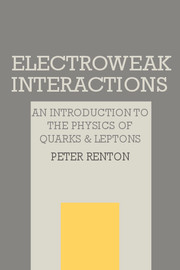Book contents
- Frontmatter
- Contents
- Preface
- 1 Introduction
- 2 Towards a quantum field theory
- 3 Wave equations, propagators and fields
- 4 Quantum electrodynamics
- 5 From Fermi theory to the standard model
- 6 Purely leptonic interactions
- 7 Deep inelastic scattering and quantum chromodynamics
- 8 Weak hadronic currents, electroweak interference effects
- 9 Quark and lepton oscillations
- 10 The standard model and beyond
- Appendix A Units
- Appendix B Properties of γ-matrices
- Appendix C Cross-sections, decay rates and Feynman rules
- Appendix D Dirac δ-function
- Appendix E Fierz transformation
- Appendix F Creation and annihilation operators for a Dirac field
- References
- Index
3 - Wave equations, propagators and fields
Published online by Cambridge University Press: 05 August 2012
- Frontmatter
- Contents
- Preface
- 1 Introduction
- 2 Towards a quantum field theory
- 3 Wave equations, propagators and fields
- 4 Quantum electrodynamics
- 5 From Fermi theory to the standard model
- 6 Purely leptonic interactions
- 7 Deep inelastic scattering and quantum chromodynamics
- 8 Weak hadronic currents, electroweak interference effects
- 9 Quark and lepton oscillations
- 10 The standard model and beyond
- Appendix A Units
- Appendix B Properties of γ-matrices
- Appendix C Cross-sections, decay rates and Feynman rules
- Appendix D Dirac δ-function
- Appendix E Fierz transformation
- Appendix F Creation and annihilation operators for a Dirac field
- References
- Index
Summary
The description of scattering processes using quantum mechanics, as discussed in Chapter 2, has two obvious deficiencies. Firstly, it is not formulated in a relativistically invariant manner. The particle spin, which was incorporated by having a multicomponent wave function, must also be treated in a Lorentz invariant way. Secondly, it deals with scattering processes where the incident particle is scattered by a force represented by a fixed potential (or effective potential). However, in high energy scattering processes particles can be created or annihilated. Fermions must be created or destroyed as particle–antiparticle pairs, whereas any number of bosons may be involved. Thus the formalism needed to discuss the interaction of particles must include these points. Indeed, great care must be taken as to the actual definition of a particle and its properties. For example, a ‘free’ electron can dissociate (see Fig. 3.1) into an electron and a photon, or more complex states involving loops of e+ e- (or any other charged particles). A ‘dressed’ particle, with which we deal experimentally, has different properties to the ‘bare’ particle, the wave equations of which are discussed in this chapter.
The fundamental particles in the standard electroweak model are the spin ½ leptons and quarks, the spin 1 gauge bosons W±, γ and Z0 (which propagate the forces), and the spin 0 Higgs bosons (which are necessary to give the W±, Z0 and the fermions their masses).
- Type
- Chapter
- Information
- Electroweak InteractionsAn Introduction to the Physics of Quarks and Leptons, pp. 104 - 145Publisher: Cambridge University PressPrint publication year: 1990

